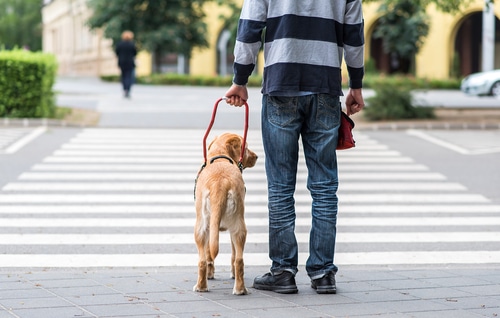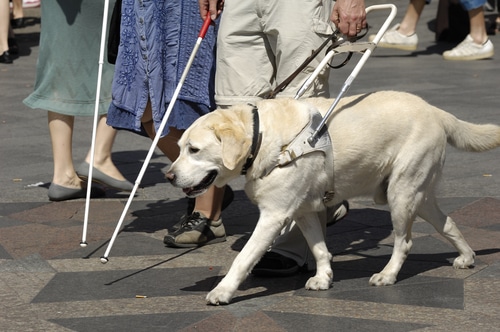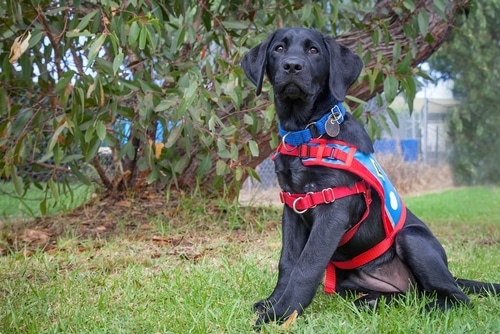International Guide Dog Day happens every year on the last Wednesday of April. It’s a time to put the spotlight on the amazing dogs that help blind and vision-impaired people get around. Because of the vital work these pups do, how to get a guide dog is one of the most asked questions people have.
In this article, we go through how you can apply to get a guide dog in Australia. Guide dogs are rare and expensive to train, so the process can be lengthy. Here’s what you need to know.
In this article

What is International Guide Dog Day?
It’s a day that celebrates the amazing work guide dogs do for people who are blind or have trouble seeing. These special dogs are trained to help their human friends safely get around places, like crossing streets, navigating through crowds, and even helping them find things they need in their daily life.
This day happens every year on the last Wednesday of April. It’s a time to appreciate and say thank you to these incredible dogs for their loyalty, intelligence, and the big difference they make in the lives of their owners.
People also use this day to spread awareness about the importance of these pups and how they help people live more independent lives. Here’s some awesome coverage of a Guide Dogs SA NT event last year:
How to get a guide dog
Getting a guide dog in Australia is a process that’s designed to match the right dog with the right person. Here’s how to go about it:
Step 1: Consider your lifestyle and needs
First, think about your daily life and how a guide dog could help you. These pups are amazing companions that can help you move around safely, but they also need care, exercise, and love. It’s like getting a new friend who’s with you all the time.
Step 2: Contact an organisation
Australia has several organisations that train and provide guide dogs. Some of the well-known ones include Guide Dogs NSW/ACT, Guide Dogs Victoria, and Guide Dogs Queensland. Find the one closest to you and reach out to them. They’re really friendly and ready to answer all your questions.
Step 3: Applying
The organisation will ask you to fill out an application. This is where you tell them about yourself, your lifestyle, and how you think a guide dog could help you. There are certain criteria you have to meet to be eligible for a guide dog. This includes:
- Vision loss: You need to have significant vision loss that impacts your mobility. This is the primary criterion since these dogs are trained to assist those who can’t rely on their vision for navigation.
- Mobility: You must be able to move around and take care of a dog. This means having a certain level of physical fitness and the ability to go for walks with your pup.
- Environment: Your living environment should be suitable for a dog. This includes having a safe and secure place for them to live and access to outdoor areas for exercise.
- Lifestyle: Your lifestyle should be able to accommodate a dog. This means considering how often you go out, the kind of activities you do, and whether you can provide a stable home for a dog.
Step 4: Assessment and training
After your application, there’s an assessment process. Someone from the organisation will meet with you to understand your needs better and see how a guide dog could fit into your life.
The process of matching a dog to a handler is meticulous, considering the needs, personality, and lifestyle of both. This can lead to a waiting period, which varies depending on the availability of suitable dogs and the specific needs of applicants.
If everything goes well, you’ll be matched with a guide dog that suits your personality and lifestyle. But, before you start your life together, you and your new furry friend will go through training. This helps both of you learn how to work together as a team.
Forming a bond with a dog and learning to work together takes time and emotional investment. It’s a partnership where both you and the dog need to trust and understand each other.
Step 5: Bringing your dog home
Once the training is done, your guide dog is ready to come home with you. But it doesn’t stop there. The organisation will continue to support you, helping with advice and more training if you need it. You and your guide dog will learn and grow together, becoming the best of friends.
FAQ
Here are some of the most-asked questions about these amazing pups, answered:
How long is the waiting period?
The time you might wait for a guide dog can change a lot based on different things. Sometimes, you might wait just a few months, but other times, it could be a couple of years.
These pups need a lot of training before they’re ready to help someone. This training usually takes about 1 and a half to 2 years. After that, they still need to learn how to work with you, which adds more time.
Lots of people want guide dogs, and there are only so many dogs ready at any time. If lots of people are waiting, you might have to wait longer, too.
Also consider people’s varying needs. Some people might need a dog that’s good at navigating busy cities, while others might need one that’s very calm. Finding a dog that meets your specific needs can make the wait longer.
How long does the training with my guide dog take?
As mentioned, after you get matched with your dog, you both will need to go through training together.
This training usually takes about 2 to 4 weeks. During this time, you’ll learn how to communicate with your dog, how to walk together safely, and how to take care of them.
You’ll practice walking in different places, like in your neighbourhood, busy streets, and other places you might go together. The goal is to make sure you and your dog are comfortable and confident moving around together before you start your everyday life as a team.
How much does a guide dog cost in Australia?
In Australia, getting a guide dog usually doesn’t cost you anything. The organisations that train guide dogs, like Guide Dogs NSW/ACT, Guide Dogs Victoria, and others, provide these amazing dogs for free to people who need them. They can do this because they get money from donations, fundraising activities, and sometimes help from the government.
Even though the dog is given to you for free, it’s important to remember that taking care of a pup does cost money. You’ll need to pay for things like food, vet visits, and other stuff your dog needs to stay healthy and happy. But the actual cost of the dog, and the training it goes through to become a guide dog, is covered by the organisation, so you don’t have to worry about that part.

Will the NDIS help pay for my guide dog?
Yes, in Australia, the National Disability Insurance Scheme (NDIS) can help cover the costs related to having a guide dog. The NDIS understands that a guide dog is not just a pet but an important helper for someone with a vision impairment. So, they can help pay for things your dog needs to do their job well, like:
- Training so it knows how to help you.
- Vet bills to keep the dog healthy.
- Food and other things the dog needs every day.
When you’re part of the NDIS, you talk about your needs, including having a guide dog, in your plan. They look at what you need to live a more independent life, and if a dog is a part of that, they can include it in your plan.
How do I insure my guide dog?
Guide dogs are a type of assistance dog, and Blue Badge Insurance offers insurance for assistance dogs and companion animals.
Your dog makes the world of difference to daily functioning. If they need medical care imagine the good feeling of providing that without worrying about footing the costs alone? Find out about getting Assistance Dogs Insurance or pet insurance today.
Click below to start your quote.








